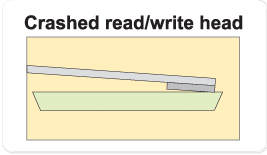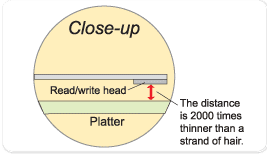![]()
What is head crash or hard disk crash ? |
|
| Home > Knowledge Base > What is head crash or hard disk crash? | |
In order to have an understaning of a head crash, some basic knowledge and theory in the architecture of hard disk should be grasped and appreciated before we have a better understanding of what exactly is head crash or most people refer to as hard disk crash. One distinguishing characteristic of hard disk technology that makes it different from how floppy disks, VCRs and tape decks work, is that the read/write heads do not make contact with the media. The reason for this is due to the high speed that the hard disk spins, and the need for the heads to frequently scan from side to side to different tracks, allowing the heads to contact the disk would result in unacceptable wear and tear to both the delicate heads and the media. |
|
|
|
Modern drive heads float over the surface of the disk and do all of their work without ever physically touching the platters they are magnetizing. The amount of space between the heads and the platters is called the floating height or flying height. It is also sometimes called the head gap, and some hard disk manufacturers refer to the heads as riding on an "air bearing". |
When the disk spins up to operating speed, the high speed causes air to flow under the sliders and lift them off the surface of the disk--the same principle of lift that operates on aircraft wings and enables them to fly. It's actually quite amazing how close to the surface of the disks the heads fly without touching. To put it into perspective, a modern hard disk has a floating height of an amazing 0.3- 0.5 microinches. A human hair has a thickness of over 2,000 microinches! Due to the very small distance from the heads to the platters--as measured in millionths of an inch --the hard disk is assembled in a clean room containing air specially filtered to remove all but the tiniest particles. Air however is required for the heads to function. It is untrue that some or most people suggest that the inside of a hard disk is maintained under a vacuum. Such misconception can easily be overturned by the fact that head ( sometimes refer to as read-write head ) of the hard disk will not be able to float if there is no air. We also heard people say that the drive's interior is "sealed" . This is also generally untrue: while the disk's internal environment is separate from the outside air to keep it clean, air exchange is permitted between the outside and inside of the drive to allow the drive to adjust to changes in air pressure. A special "breather" filter is installed to prevent foreign matter from contaminating the drive. |
|
| Since the read/write heads of a hard disk are floating on a microscopic layer of air above the disk platters themselves, it is possible that the heads can make contact with the media on the hard disk under certain circumstances. Normally, the heads only contact the surface when the drive is either starting up or stopping. | |
 |
If the heads contact the surface of the disk while it is at operational speed, the result can be loss of data, damage to the heads, damage to the surface of the disk, or all three. This is usually called a head crash, the two most frightening words to any computer user as it could mean permanent loss of critical data if it is not recoverable. |
The most common causes of head crashes are:
Taking precautions to avoid head crashes, especially not abusing the drive physically, is obviously common sense. Be extra careful with portable computers like laptop and external USB hard disks; never try to move the unit while the hard disk is active. |
|


